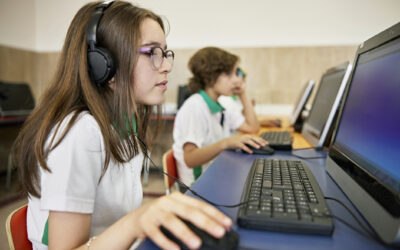What is Digital Literacy Curriculum?
Digital literacy curriculum is sequential learning that teaches students how to effectively and safely use and understand technology. It is sometimes also referred to as “technology literacy” or “information and technology literacy.”
The “digital” part of digital literacy refers to all forms of technology while “literacy” means competence or knowledge, referring to the ability to use, understand and stay safe while using technology.
What is Included in Digital Literacy Curriculum?
There are several components of digital literacy, and not every program is the same. However, there are several subjects that are part of a successful digital literacy program, such as:
1. Online Safety
One of the most important components of digital literacy curriculum is online safety. As online threats continue to multiply and increase in complexity, it’s more important than ever that our children get an early start in learning how to keep themselves safe online. While this subject cannot possibly touch on every type of cyber threat, especially since these threats evolve quickly, it is important that it include safety rules regarding privacy, identifying common threats, what to do if your information is breached or compromised and how to mitigate risk. Online safety is so important to students, that schools are required to teach it to achieve CIPA compliance and qualify for E-rate.
2. Computer Fundamentals
Expanded to include general technology fundamentals, computer fundamentals include the ability to identify different components of a computer or other technological device and to know how to use them. This includes identifying sources of power as well as how to power on the device, identifying file/data storage and how to use it, utilizing an operating system and applications and beyond.
3. Keyboarding/Typing
Keyboarding and typing are common components of digital literacy curriculum. While voice-to-text, AI and interpretive programs are becoming more common, the ability to keyboard is still considered an important skill in working effectively and efficiently with most technology.
4. Communication
Communication in digital literacy curriculum typically encompasses how to share and distribute information online. This includes email, forums, messaging applications, team collaboration apps and more. The focus is not only on how to use these applications effectively, but also how to do so in an effective and appropriate manner.
5. Multimedia Use
From videos and audio to reels, slide presentations, imagery and beyond, the variety of media available through technology continues to improve and adapt, offering more opportunities to share information in increasingly creative and effective ways. In a digital literacy curriculum, it’s common for students to learn about different types of media as well as when and how to use them.
6. Digital Citizenship
Digital citizenship, like online safety, is the ability to use technology safely and responsibly. However, this part of a digital literacy curriculum is more likely to focus on personal responsibility and respect. For instance, digital citizenship will address topics such as how to handle cyberbullying, validate sources and use resources while respecting copyright laws.
7. Computational Thinking
Computational thinking has gained attention in recent years for its importance in digital literacy curriculum. Computational thinking refers to the ability to align problem-solving with technology-based solutions. It includes thinking about a problem as a solution as a process as opposed to a black-and-white answer. It focuses on approaching problem solving with a mindset of critical thinking, creativity and innovation to produce an algorithmic problem-solving process that can be replicated or utilized in similar problems.
Final Thoughts
While digital literacy curriculum may differ between programs, finding a solution that encompasses today’s–and tomorrow’s–critical digital skills is imperative to equipping future-ready students as effectively as possible.

Learning.com Team
Staff Writers
Founded in 1999, Learning.com provides educators with solutions to prepare their students with critical digital skills. Our web-based curriculum for grades K-12 engages students as they learn keyboarding, online safety, applied productivity tools, computational thinking, coding and more.
Further Reading
Understanding Proclamation 2024 and the TA-TEKS
Understanding Proclamation 2024 and the TA-TEKS In 2024, Texas introduced Proclamation 2024 to begin the process of adopting new instructional...
Guide to Teaching Algorithms in Computer Programming for K-12 Students
Algorithms are the heart of computer programming, providing the step-by-step instructions that computers follow to perform tasks and solve problems....
Planning Digital Literacy Assessment: A Simplified Approach
As educators know, assessments are critical to the learning process. They provide beneficial self-checks to students, informative results to...




